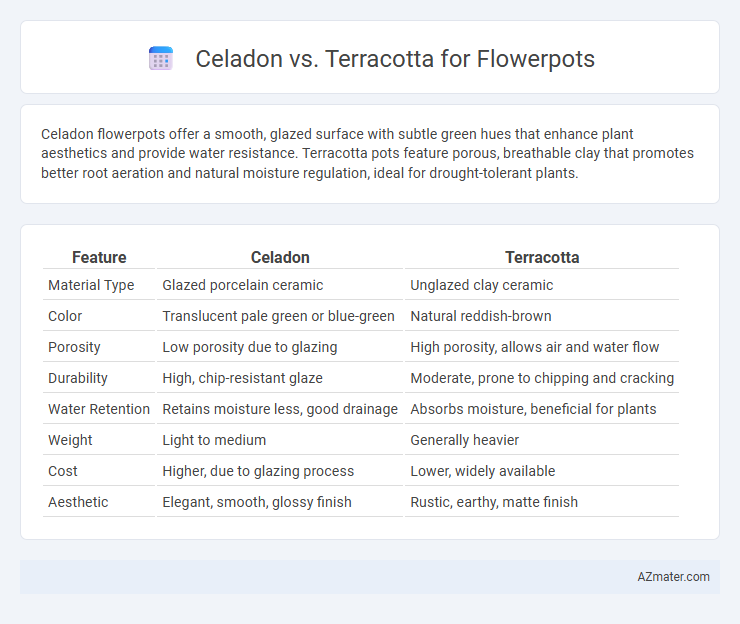Celadon flowerpots offer a smooth, glazed surface with subtle green hues that enhance plant aesthetics and provide water resistance. Terracotta pots feature porous, breathable clay that promotes better root aeration and natural moisture regulation, ideal for drought-tolerant plants.
Table of Comparison
| Feature | Celadon | Terracotta |
|---|---|---|
| Material Type | Glazed porcelain ceramic | Unglazed clay ceramic |
| Color | Translucent pale green or blue-green | Natural reddish-brown |
| Porosity | Low porosity due to glazing | High porosity, allows air and water flow |
| Durability | High, chip-resistant glaze | Moderate, prone to chipping and cracking |
| Water Retention | Retains moisture less, good drainage | Absorbs moisture, beneficial for plants |
| Weight | Light to medium | Generally heavier |
| Cost | Higher, due to glazing process | Lower, widely available |
| Aesthetic | Elegant, smooth, glossy finish | Rustic, earthy, matte finish |
Introduction to Celadon and Terracotta Flowerpots
Celadon flowerpots feature a smooth, jade-green glaze that enhances both the aesthetic and durability of ceramic containers, making them ideal for indoor and decorative gardening. Terracotta flowerpots, crafted from natural clay, offer excellent breathability and moisture regulation, promoting healthy root systems in outdoor and traditional gardening setups. These distinct materials cater to varying botanical needs and design preferences, with celadon pots providing a refined, glossy finish and terracotta pots delivering a classic, porous texture.
Origins and Historical Significance
Celadon flowerpots trace their origins to ancient China during the Song Dynasty, celebrated for their jade-like glaze symbolizing elegance and refinement in East Asian ceramics. Terracotta flowerpots have been used since prehistoric times in Mediterranean and Mesoamerican cultures, valued for their porous clay material that supports plant health and reflects rustic craftsmanship. Both materials carry rich historical significance: celadon embodies prestige and artistic mastery, while terracotta represents durability and timeless simplicity in horticultural traditions.
Material Composition and Manufacturing
Celadon flowerpots are typically crafted from porcelain clay rich in kaolin, giving them a smooth texture and translucent glaze achieved through high-temperature firing that creates their signature jade-green finish. Terracotta pots are made from natural earthen clay, which is coarser and fired at lower temperatures, resulting in a porous, porous reddish-brown material ideal for breathability and moisture regulation. The manufacturing of celadon involves precise glazing and kiln control to achieve its glossy surface, while terracotta production emphasizes molding and low-temperature firing for durability and rustic aesthetics.
Visual Aesthetics: Color, Texture, and Glaze
Celadon flowerpots feature a smooth, translucent glaze with subtle greenish-blue hues that enhance plant vibrancy, while terracotta pots offer a warm, earthy red-brown tone with a porous, matte texture ideal for natural appeal. The glossy finish of celadon pots creates a refined, elegant look that contrasts with the rustic, handmade feel of terracotta. Color saturation in celadon highlights intricate glaze variations, whereas terracotta's texture emphasizes organic imperfections and breathability.
Durability and Weather Resistance
Celadon flowerpots, made from high-fired ceramics with a glazed surface, exhibit superior durability and excellent resistance to moisture, making them ideal for outdoor use in various weather conditions. Terracotta pots, crafted from porous clay, offer good breathability but are more susceptible to cracking under extreme cold and prolonged exposure to moisture. Choosing celadon ensures enhanced weather resistance and longevity, whereas terracotta requires careful winter protection to maintain its structural integrity.
Porosity and Water Retention Capabilities
Celadon flowerpots feature a glazed surface that significantly reduces porosity, limiting water absorption and enhancing water retention for delicate plants requiring consistent moisture. In contrast, terracotta pots are unglazed and highly porous, allowing for better air circulation but faster evaporation, which is ideal for plants preferring drier soil conditions. The choice between celadon and terracotta directly impacts soil moisture levels and root aeration, influencing plant health and growth.
Suitability for Different Plant Types
Celadon flowerpots, with their glazed finish, provide excellent moisture retention ideal for moisture-loving plants such as ferns and orchids. Terracotta pots, being porous, offer superior aeration and drainage suitable for succulents, cacti, and herbs that require well-drained soil. Selecting between Celadon and Terracotta depends on the specific water and breathability needs of the plant species.
Cost Comparison and Market Availability
Celadon flowerpots typically cost more than terracotta due to their intricate glazing process and aesthetic appeal. Terracotta pots are widely available and generally affordable, dominating the market with their natural, porous material ideal for plant health. While celadon pots are favored for decorative purposes, terracotta remains the cost-effective and easily accessible option for everyday gardening.
Environmental Impact and Sustainability
Celadon flowerpots, typically made from glazed porcelain, offer durability and reusability but require high-energy kiln firing processes, which contribute to a larger carbon footprint compared to terracotta. Terracotta pots, made from natural clay and fired at lower temperatures, exhibit better biodegradability and have a lower environmental impact due to their natural composition and energy-efficient production. Both materials can be sustainable if reused extensively, but terracotta generally aligns more closely with eco-friendly gardening practices due to its minimal processing and ability to naturally break down over time.
Choosing the Right Flowerpot: Celadon or Terracotta?
Choosing between celadon and terracotta flowerpots depends on plant needs and aesthetic preferences. Celadon pots, glazed with a smooth, water-resistant surface, are ideal for moisture-loving plants as they retain soil humidity longer. Terracotta pots offer excellent breathability and drainage through their porous material, making them perfect for succulents and plants requiring well-aerated soil to prevent root rot.

Infographic: Celadon vs Terracotta for Flowerpot
 azmater.com
azmater.com